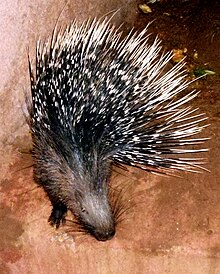| Revision as of 18:30, 6 March 2015 editHelpsome (talk | contribs)Autopatrolled, Rollbackers11,373 edits Undid revision 650167151 by Haffy881 (talk) WP:COPYVIO http://animaldiversity.org/accounts/Hystrix_indica/← Previous edit | Revision as of 05:32, 10 April 2015 edit undoAditya4wiki (talk | contribs)18 editsNo edit summaryNext edit → | ||
| Line 21: | Line 21: | ||
| Many conservationists, most notably ] and ], have documented and noted that many tigers and leopards have become man-eaters after having fought and been injured by porcupines, which indicates their ferocity and their lack of predators. One such example was the ], which when examined, was shown to have two porcupine quills lodged in its right forefoot. | Many conservationists, most notably ] and ], have documented and noted that many tigers and leopards have become man-eaters after having fought and been injured by porcupines, which indicates their ferocity and their lack of predators. One such example was the ], which when examined, was shown to have two porcupine quills lodged in its right forefoot. | ||
| '''Red Porcupine''': | |||
| The Indian crested porcupine has multi-banded black and white quills. The southern race of the species which is found in the central and southern India has reddish-brown quills hence reffered to as Red Porcupine. | |||
| ] | |||
| ] | ] | ||
| ] | ] | ||
Revision as of 05:32, 10 April 2015
| Indian crested porcupine | |
|---|---|

| |
| Conservation status | |
 Least Concern (IUCN 3.1) | |
| Scientific classification | |
| Kingdom: | Animalia |
| Phylum: | Chordata |
| Class: | Mammalia |
| Order: | Rodentia |
| Family: | Hystricidae |
| Genus: | Hystrix |
| Subgenus: | Hystrix |
| Species: | H. indica |
| Binomial name | |
| Hystrix indica Kerr, 1792 | |
The Indian crested porcupine (Hystrix indica), or Indian porcupine, is a member of the Old World porcupines. It is quite an adaptable rodent, found throughout southern Asia and the Middle East. It is tolerant of several different habitats: mountains, tropical and subtropical grasslands, scrublands, and forests. It is a large rodent, growing more than 0.9 m (3 ft) long and weighing 14.5 kg (32 lb). It is covered in multiple layers of quills. The longest quills grow from its shoulders to about a third of the animal's length. Its tail is covered in short, hollow quills that can rattle when threatened. It has broad feet and long claws for digging. When attacked, the Indian crested porcupine raises its quills and rattles the hollow quills on its tail. If the predator persists past these threats, the porcupine launches a backwards assault, hoping to stab its attacker with its quills. It does this so effectively that most brushes between predators and the Indian porcupine end in death or severe injury.
Not much is known about the average life span of the Indian crested porcupine. Nevertheless it produces litters of variable size (four at the largest) each year. The Indian crested porcupine is nocturnal and creates underground shelters. It eats a variety of plants including their fruits, grains, and roots. Its diet of plant matter makes it an agricultural pest to farmers in some parts of India. In addition, the Indian porcupine has been observed gnawing on bones to extract the minerals they contain. Many conservationists, most notably Jim Corbett and Kenneth Anderson, have documented and noted that many tigers and leopards have become man-eaters after having fought and been injured by porcupines, which indicates their ferocity and their lack of predators. One such example was the Leopard of Gummalapur, which when examined, was shown to have two porcupine quills lodged in its right forefoot.
Red Porcupine: The Indian crested porcupine has multi-banded black and white quills. The southern race of the species which is found in the central and southern India has reddish-brown quills hence reffered to as Red Porcupine.



References
- Template:IUCN2008
- Chakravarthy, A. K.; Girish, A. C.; Shakunthata Sridhara (2006) Pest status of the Indian crested porcupine, Hystrix indica. Authors in Vertebrate pests in agriculture: the Indian scenario (editor Shakunthala Sridhara Book). pages. 287-300 ISBN 81-7233-436-2
| Extant species of family Hystricidae (Old World porcupines) | |
|---|---|
| |
| Atherurus | |
| Hystrix | |
| Trichys | |
| Category | |
Categories: